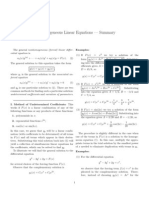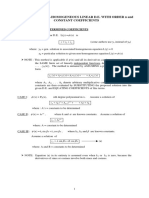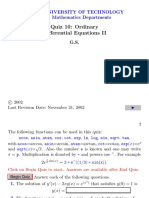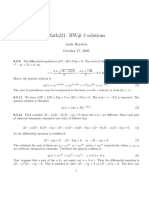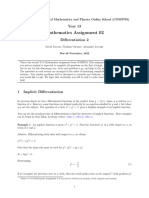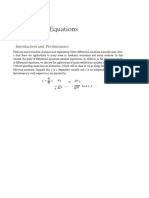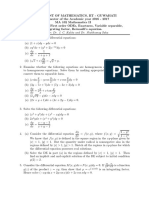2016 Lecture5
Uploaded by
Rehan Gaming2016 Lecture5
Uploaded by
Rehan GamingOrdinary Differential Equations
(MA102 Mathematics II)
Shyamashree Upadhyay
IIT Guwahati
Shyamashree Upadhyay ( IIT Guwahati ) Ordinary Differential Equations 1 / 15
Method of Undetermined Coefficients
To solve a nonhomogeneous linear differential equation
an y(n) + an−1 y(n−1) + · · · + a1 y0 + a0 y = g(x) (1)
we must do two things:
(i) Find a complementary function yc .
(ii) Find any particular solution y p of the nonhomogeneous equation.
Then the general solution of (1) is y = yc + y p . We already know how to find yc when the
coefficients an , an−1 , . . . , a0 are constants. We will now prescribe a method to find a
particular solution y p called the method of undetermined coefficients.
The underlying idea in this method is an educated guess, about the form of y p , motivated
by the kind of functions that comprise g(x). This method is regretably limited to
nonhomogeneous linear equations like (1) where
the coefficients ai , i = 0, 1, . . . , n are constants and
g(x) is a constant k, or a polynomial function, or an exponential function eαx , or sine
or cosine function (like sinβx, cosβx), or finite sums and products of these functions.
Shyamashree Upadhyay ( IIT Guwahati ) Ordinary Differential Equations 2 / 15
Undetermined Coefficients contd ...
That is, g(x) is a linear combination of functions of the type
k(constant), xn , xn eαx , xn eαx cos βx, xn eαx sin βx,
where n is a nonnegative integer and α and β are real numbers. The method of
undetermined coefficients is not applicable to equations of form (1) when
1
g(x) = ln x, g(x) = , g(x) = tan x, g(x) = sin−1 x,
x
ad so on. The set of functions that consists of constants, polynomials, exponentials, sines
and cosines has the remarkable property that derivatives of their sums and products are
again sums and products of constants, polynomials, exponentials, sines and cosines.
p + an−1 y p
Since the lienar combination of derivatives an y(n) + · · · + a1 y0p + a0 y p must be
(n−1)
identical to g(x), it seems reasonable to assume that y p has the same form as g(x).
Shyamashree Upadhyay ( IIT Guwahati ) Ordinary Differential Equations 3 / 15
Examples
Example
Solve y00 + 4y0 − 2y = 2x2 − 3x + 6.√ √
It is easy to check that yc = c1 e−(2+ 6)x + c2 e(−2+ 6)x . Now since the function g(x) is a
quadratic polynomial, let us assume that a particular solution y p is also of the same form.
So take
y p = Ax2 + Bx + C.
Then we get y00p + 4y0p − 2y p = 2A + 8Ax + 4B − 2Ax2 − 2Bx − 2C . We want y00p + 4y0p − 2y p to
be equal to g(x) = 2x2 − 3x + 6. So equating 2A + 8Ax + 4B − 2Ax2 − 2Bx − 2C with
2x2 − 3x + 6, we can get the values of the coefficients A, B and C . Here we get
A = −1, B = − 52 , C = −9. Thus a particular solution is y p = −x2 − 25 x − 9 and the general
solution is
√ √ 5
y = yc + y p = c1 e−(2+ 6)x
+ c2 e(−2+ 6)x
− x2 − x − 9.
2
Shyamashree Upadhyay ( IIT Guwahati ) Ordinary Differential Equations 4 / 15
Examples contd ...
Example
Solve y00 − y0 + y = 2sin 3x.
A natural first guess for a particular solution would be Asin 3x. But since successive
differentiations of sin 3x produce sin 3x as well as cos 3x, therefore we are prompted
instead to assume a particular solution that includes both sin 3x and cos 3x. So we take
y p = Acos 3x + Bsin 3x.
And then we proceed similarly as in the previous example to compute the values of A and
B.
Shyamashree Upadhyay ( IIT Guwahati ) Ordinary Differential Equations 5 / 15
Example: Forming y p by superposition
Example
Solve y00 − 2y0 − 3y = 4x − 5 + 6xe2x .
In this example, the presence of 4x − 5 in g(x) suggests that the particular solution must
include a linear polynomial. Furthermore, the presence of 6xe2x in g(x) and the fact that
derivative of the product xe2x produces 2xe2x and e2x , suggest that the particular solution
must include both xe2x and e2x . In other words, g is the sum of two basic kinds of functions:
g(x) = g1 (x) + g2 (x) = polynomial + exponential.
Correspondingly, the superposition principle for nonhomogeneous equations suggest that
we seek a particular solution
y p = y p1 + y p2
where y p1 = Ax + B and y p2 = Cxe + De2x . So take y p = Ax + B + Cxe2x + De2x and solve
2x
the DE as in the earlier example.
Shyamashree Upadhyay ( IIT Guwahati ) Ordinary Differential Equations 6 / 15
A glitch in the method
Example
Find a particular solution of y00 − 5y0 + 4y = 8e x .
Here g(x) = 8e x and differentiation of e x produces no new functions. Thus it seems
reasonable to assume a particular solution of the form y p = Ae x . But substituting y p = Ae x
in the DE yields 0 = 8e x , which is absurd. So clearly we had made a wrong guess for y p .
The difficulty here is apparent upon examining the complementary function
yc = c1 e x + c2 e4x . Observe that our assumption Ae x is already present in yc in the form c1 e x .
This means that e x is a solution of the associated homogeneous DE, and a constant
multiple Ae x when substituted into the DE necessarily produces 0.
What then should be the form of y p ? Let us see whether we can find a particular solution of
the form y p = Axe x or not! Substituting y p = Axe x in the given DE, we get
y00p − 5y0p + 4y p = −3Ae x = 8e x . This implies that A = − 38 . Hence a particular solution of the
given DE is y p = − 38 xe x .
This example suggests us to consider 2 cases.
Shyamashree Upadhyay ( IIT Guwahati ) Ordinary Differential Equations 7 / 15
Case I
Recall the equation
an y(n) + an−1 y(n−1) + · · · + a1 y0 + a0 y = g(x) (1)
Case I: No function in the assumed particular solution is a solution of the associated
homogeneous DE.
In the table that follows, we illustrate some specific examples of g(x) in (1) along with the
corresponding form of the particular solution. We are, of course, taking for granted that no
function in the assumed particular solution y p is duplicated by a function in the
complementary function yc .
Form Rule for Case I: The form of y p is a linear combination of all linearly independent
functions that are generated by repeated differentiations of g(x).
Shyamashree Upadhyay ( IIT Guwahati ) Ordinary Differential Equations 8 / 15
Table for Case I
Trial particular solutions
g(x) Form o f y p
k(any constant) A
5x + 7 Ax + B
3x2 − 2 Ax2 + Bx + C
x3 − x + 1 Ax3 + Bx2 + Cx + D
sin βx Acos βx + Bsin βx
cos βx Acos βx + Bsin βx
eαx Aeαx
(9x − 2)eαx (Ax + B)eαx
x2 eαx (Ax2 + Bx + C)eαx
eαx sin βx Aeαx cos βx + Beαx sin βx
5x2 sin βx (Ax2 + Bx + C)cos βx + (Ex2 + F x + G)sin βx
xeαx cos βx (Ax + B)eαx cos βx + (Cx + D)eαx sin βx
Shyamashree Upadhyay ( IIT Guwahati ) Ordinary Differential Equations 9 / 15
Example for Case I
Example
Find a particular solution of y00 − 9y0 + 14y = 3x2 − 5sin 2x + 7xe6x .
Solution: Corresponding to 3x2 we assume y p1 = Ax2 + Bx + C .
Corresponding to −5sin 2x we assume y p2 = Ecos 2x + F sin 2x.
Corresponding to 7xe6x we assume y p3 = (Gx + H)e6x .
The assumption for the particular solution for the given DE is then
y p = y p1 + y p2 + y p3 = Ax2 + Bx + C + Ecos 2x + F sin 2x + (Gx + H)e6x .
Observe that no term in this assumed y p duplicates any term in yc = c1 e2x + c2 e7x .
Shyamashree Upadhyay ( IIT Guwahati ) Ordinary Differential Equations 10 / 15
Case II
Case II: A function in the assumed particular solution is also a solution of the associated
homogeneous DE.
Example
Problem: Find a particular solution of y00 − 2y0 + y = e x .
The complementary function is yc = c1 e x + c2 xe x . So the assumption y p = Ae x will fail since
it is apparent from yc that e x is a solution of the associated homogeneous equation
y00 − 2y0 + y = 0. Moreover, we will not be able to find a particular solution of the form
y p = Axe x since the term xe x is also duplicated in yc . We next try
y p = Ax2 e x .
Substituting into the given DE yields
1
2Ae x = e x and so A = .
2
Thus a particular solution is y p = 12 x2 e x .
Shyamashree Upadhyay ( IIT Guwahati ) Ordinary Differential Equations 11 / 15
Case II contd ...
Suppose again that g(x) consists of m terms of the kind given in the previous table, and
suppose further that the usual assumption for a particular solution is
y p = y p1 + y p2 + · · · + y pm ,
where the y pi , i = 1, 2, · · · , m are the trial particular solution forms corresponding to these
terms. Under the circumstances described in Case II, we can make up the following
general rule:
Multiplication Rule for case II: If any y pi contains terms that duplicate terms in yc , then
that y pi must be multiplied by x s , where s is the smallest positive integer that eliminates that
duplication.
Shyamashree Upadhyay ( IIT Guwahati ) Ordinary Differential Equations 12 / 15
Using the Multiplication Rule, Case II
Example
Problem: Solve y00 − 6y0 + 9y = 6x2 + 2 − 12e3x .
The complementary function is yc = c1 e3x + c2 xe3x . And so, the usual assumption (based
on the table) for a particular solution would be
y p = Ax2 + Bx + C + Ee3x
where y p1 = Ax2 + Bx + C and y p2 = Ee3x . Inspection of these functions show that the one
term in y p2 is duplicated in yc . If we multiply y p2 by x, we note that the term xe3x is still a
part of yc . But multiplying y p2 by x2 eliminates all duplications. Thus the operative form of a
particular solution is
y p = Ax2 + Bx + C + Ex2 e3x .
Shyamashree Upadhyay ( IIT Guwahati ) Ordinary Differential Equations 13 / 15
A comprehensive list
Shyamashree Upadhyay ( IIT Guwahati ) Ordinary Differential Equations 14 / 15
A comprehensive list contd ...
Shyamashree Upadhyay ( IIT Guwahati ) Ordinary Differential Equations 15 / 15
You might also like
- Full Download Biological and Bio inspired Nanomaterials Properties and Assembly Mechanisms Sarah Perrett PDF DOCX100% (3)Full Download Biological and Bio inspired Nanomaterials Properties and Assembly Mechanisms Sarah Perrett PDF DOCX41 pages
- MAT101 Mathematics For Business - UEH-ISB - S1 2021 - Unit Guide (Revised Nov 2020)No ratings yetMAT101 Mathematics For Business - UEH-ISB - S1 2021 - Unit Guide (Revised Nov 2020)13 pages
- Non-Homogeneous Equations - Undetermined CoefficientsNo ratings yetNon-Homogeneous Equations - Undetermined Coefficients20 pages
- MATH 1005H: Fall 2015 Test Two SolutionsNo ratings yetMATH 1005H: Fall 2015 Test Two Solutions2 pages
- MATH 1005B: Winter 2015 Test One (Version A) SolutionsNo ratings yetMATH 1005B: Winter 2015 Test One (Version A) Solutions3 pages
- Differential Equations - MTH401 Handouts Lecture 17No ratings yetDifferential Equations - MTH401 Handouts Lecture 1715 pages
- Nonhomogeneous Linear Equations - SummaryNo ratings yetNonhomogeneous Linear Equations - Summary2 pages
- Math2065: Intro To Pdes Tutorial Solutions (Week 1) : 3t 5 (1 Z) 3t 3t 4 3 3tNo ratings yetMath2065: Intro To Pdes Tutorial Solutions (Week 1) : 3t 5 (1 Z) 3t 3t 4 3 3t3 pages
- Calculus I: Unit 11: Differential EquationsNo ratings yetCalculus I: Unit 11: Differential Equations50 pages
- Maths Linear Differential Equation BSC 2semseterNo ratings yetMaths Linear Differential Equation BSC 2semseter18 pages
- WINSEM2023-24 BMAT102L TH VL2023240501530 2024-01-31 Reference-Material-IINo ratings yetWINSEM2023-24 BMAT102L TH VL2023240501530 2024-01-31 Reference-Material-II4 pages
- Differential Equations of First Order - Part 2: DR Alina GleskaNo ratings yetDifferential Equations of First Order - Part 2: DR Alina Gleska29 pages
- Ordinary Differential Equations: Prepared byNo ratings yetOrdinary Differential Equations: Prepared by36 pages
- 12th-Maths-Chapter-10-Question-Paper-English-Medium-PDF-Download (1)No ratings yet12th-Maths-Chapter-10-Question-Paper-English-Medium-PDF-Download (1)3 pages
- Differential Equations: Introduction and PreliminariesNo ratings yetDifferential Equations: Introduction and Preliminaries4 pages
- Instructor: Dr. J. C. Kalita and Dr. Shubhamay SahaNo ratings yetInstructor: Dr. J. C. Kalita and Dr. Shubhamay Saha3 pages
- Linear Second Order Ode: Differential EquationsNo ratings yetLinear Second Order Ode: Differential Equations36 pages
- Nonhomogeneous Linear Equations (Section 17.2)No ratings yetNonhomogeneous Linear Equations (Section 17.2)46 pages
- Mathematics 1St First Order Linear Differential Equations 2Nd Second Order Linear Differential Equations Laplace Fourier Bessel MathematicsFrom EverandMathematics 1St First Order Linear Differential Equations 2Nd Second Order Linear Differential Equations Laplace Fourier Bessel MathematicsNo ratings yet
- 1.3.4 Practice - Modeling_ Multistep Linear Equations (Practice)No ratings yet1.3.4 Practice - Modeling_ Multistep Linear Equations (Practice)4 pages
- General Mathematics Activity Sheet Week 5 6No ratings yetGeneral Mathematics Activity Sheet Week 5 64 pages
- Fairfield Methodist - 11 Prelims - A Maths - Paper 1No ratings yetFairfield Methodist - 11 Prelims - A Maths - Paper 18 pages
- PHASE PLANNER-2021-22 CLASS: 12th Studying (CSO)No ratings yetPHASE PLANNER-2021-22 CLASS: 12th Studying (CSO)1 page
- Suggestionof Empirical Equationsfor Damping Ratioof PlasticanNo ratings yetSuggestionof Empirical Equationsfor Damping Ratioof Plastican7 pages
- Lesson 4 Homework Practice Linear Functions Course 3 Chapter 4100% (1)Lesson 4 Homework Practice Linear Functions Course 3 Chapter 46 pages
- Structural Dynamics With Applications in Earthquake and Wind Engineering 2nd Ed. Konstantin Meskouris, Christoph Butenweg Etc.No ratings yetStructural Dynamics With Applications in Earthquake and Wind Engineering 2nd Ed. Konstantin Meskouris, Christoph Butenweg Etc.610 pages
- Department of Education Schools Division Office I PangasinanNo ratings yetDepartment of Education Schools Division Office I Pangasinan3 pages
- Example, Describe A Context in Which A Total Number of Objects Can Be Expressed As 5 × 7No ratings yetExample, Describe A Context in Which A Total Number of Objects Can Be Expressed As 5 × 714 pages
- Roots of Algeraic and Transcendental Equations: SAEED AHMED SHAH (A.P) QUEST NAWABSHAH Contact# 03342134532No ratings yetRoots of Algeraic and Transcendental Equations: SAEED AHMED SHAH (A.P) QUEST NAWABSHAH Contact# 0334213453215 pages
- AIMS Master of Mathematics For Teachers (AMMT)No ratings yetAIMS Master of Mathematics For Teachers (AMMT)1 page
- Trig-2 (Trigonometric Equations & Inequations) 13thNo ratings yetTrig-2 (Trigonometric Equations & Inequations) 13th6 pages
- Dilwyn Edwards & Michael Hamson - Mathematical Modeling Skills100% (2)Dilwyn Edwards & Michael Hamson - Mathematical Modeling Skills177 pages
- Klein Limit Hbar To Zero Quantum Theory AjpNo ratings yetKlein Limit Hbar To Zero Quantum Theory Ajp9 pages
- Full Download Biological and Bio inspired Nanomaterials Properties and Assembly Mechanisms Sarah Perrett PDF DOCXFull Download Biological and Bio inspired Nanomaterials Properties and Assembly Mechanisms Sarah Perrett PDF DOCX
- MAT101 Mathematics For Business - UEH-ISB - S1 2021 - Unit Guide (Revised Nov 2020)MAT101 Mathematics For Business - UEH-ISB - S1 2021 - Unit Guide (Revised Nov 2020)
- Non-Homogeneous Equations - Undetermined CoefficientsNon-Homogeneous Equations - Undetermined Coefficients
- MATH 1005B: Winter 2015 Test One (Version A) SolutionsMATH 1005B: Winter 2015 Test One (Version A) Solutions
- Differential Equations - MTH401 Handouts Lecture 17Differential Equations - MTH401 Handouts Lecture 17
- Math2065: Intro To Pdes Tutorial Solutions (Week 1) : 3t 5 (1 Z) 3t 3t 4 3 3tMath2065: Intro To Pdes Tutorial Solutions (Week 1) : 3t 5 (1 Z) 3t 3t 4 3 3t
- WINSEM2023-24 BMAT102L TH VL2023240501530 2024-01-31 Reference-Material-IIWINSEM2023-24 BMAT102L TH VL2023240501530 2024-01-31 Reference-Material-II
- Differential Equations of First Order - Part 2: DR Alina GleskaDifferential Equations of First Order - Part 2: DR Alina Gleska
- 12th-Maths-Chapter-10-Question-Paper-English-Medium-PDF-Download (1)12th-Maths-Chapter-10-Question-Paper-English-Medium-PDF-Download (1)
- Differential Equations: Introduction and PreliminariesDifferential Equations: Introduction and Preliminaries
- Instructor: Dr. J. C. Kalita and Dr. Shubhamay SahaInstructor: Dr. J. C. Kalita and Dr. Shubhamay Saha
- Mathematics 1St First Order Linear Differential Equations 2Nd Second Order Linear Differential Equations Laplace Fourier Bessel MathematicsFrom EverandMathematics 1St First Order Linear Differential Equations 2Nd Second Order Linear Differential Equations Laplace Fourier Bessel Mathematics
- 1.3.4 Practice - Modeling_ Multistep Linear Equations (Practice)1.3.4 Practice - Modeling_ Multistep Linear Equations (Practice)
- Fairfield Methodist - 11 Prelims - A Maths - Paper 1Fairfield Methodist - 11 Prelims - A Maths - Paper 1
- Suggestionof Empirical Equationsfor Damping Ratioof PlasticanSuggestionof Empirical Equationsfor Damping Ratioof Plastican
- Lesson 4 Homework Practice Linear Functions Course 3 Chapter 4Lesson 4 Homework Practice Linear Functions Course 3 Chapter 4
- Structural Dynamics With Applications in Earthquake and Wind Engineering 2nd Ed. Konstantin Meskouris, Christoph Butenweg Etc.Structural Dynamics With Applications in Earthquake and Wind Engineering 2nd Ed. Konstantin Meskouris, Christoph Butenweg Etc.
- Department of Education Schools Division Office I PangasinanDepartment of Education Schools Division Office I Pangasinan
- Example, Describe A Context in Which A Total Number of Objects Can Be Expressed As 5 × 7Example, Describe A Context in Which A Total Number of Objects Can Be Expressed As 5 × 7
- Roots of Algeraic and Transcendental Equations: SAEED AHMED SHAH (A.P) QUEST NAWABSHAH Contact# 03342134532Roots of Algeraic and Transcendental Equations: SAEED AHMED SHAH (A.P) QUEST NAWABSHAH Contact# 03342134532
- Trig-2 (Trigonometric Equations & Inequations) 13thTrig-2 (Trigonometric Equations & Inequations) 13th
- Dilwyn Edwards & Michael Hamson - Mathematical Modeling SkillsDilwyn Edwards & Michael Hamson - Mathematical Modeling Skills















